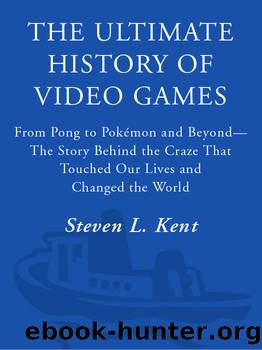The Ultimate History of Video Games: from Pong to Pokemon and beyond...the story behind the craze that touched our lives and changed the world by Steven L. Kent

Author:Steven L. Kent [Kent, Steven L.]
Language: eng
Format: azw3, mobi
Publisher: Three Rivers Press
Published: 2020-09-11T16:00:00+00:00
One of Tim Stamper’s first games, JetPac , was a major success by Sinclair standards. Nearly one million people owned Sinclair Spectrum computers in 1983, and ACG sold more than 300,000 copies of JetPac.
It was incredible penetration for a single product.
We had an advantage—we’d been working on an arcade product. We just took that expertise and transferred it directly to the Sinclair Spectrum.
—Chris Stamper
Toward the end of 1983, Hochberg visited Tokyo. While there, he saw a Famicom and instantly recognized it as the future of video games. He purchased a console and sent it to the Stampers to get their reaction.
The Stampers were not immediately impressed. Nintendo had not begun exporting Famicom from Japan at the time, and the Stampers were not convinced that they wanted to deal with the Japanese market. They preferred to work on computer games. At the time, it seemed as if computers were the only viable market for electronic games. With a little prodding from Hochberg, the Stampers agreed that they would design games for the Famicom system if Nintendo started shipping to the United States and Europe.
In order to make games for the new system, however, they needed to obtain system specifications, schematics, and a license to make games from Nintendo. As an arcade owner, Hochberg was familiar with Nintendo of America. He made an appointment with Minoru Arakawa and flew out to Redmond, Washington, to propose a partnership.
I contacted Nintendo and found out that they were not completely interested in sharing the technical specs with us. My question to Mr. Arakawa was, “Why?”
He said, “You have to prove that you have the technical expertise,” which was not a bad answer.
Chris spent a good deal of time, practically six months, reverse engineering the hardware and then proceeded to do for me an audiovisual display, very simple but utilizing graphic and other capabilities of the hardware that would show what we could do. We really weren’t interested in giving Nintendo a product; we were interested in giving Nintendo a view of what could be done.
When I sent that off to Nintendo, Mr. Arakawa said, “I like what I see. Now please do a game.”
But he still did not give us the technical specs at that point.
—Joel Hochberg
Download
The Ultimate History of Video Games: from Pong to Pokemon and beyond...the story behind the craze that touched our lives and changed the world by Steven L. Kent.mobi
This site does not store any files on its server. We only index and link to content provided by other sites. Please contact the content providers to delete copyright contents if any and email us, we'll remove relevant links or contents immediately.
Deep Learning with Python by François Chollet(11896)
Hello! Python by Anthony Briggs(9373)
OCA Java SE 8 Programmer I Certification Guide by Mala Gupta(9343)
The Mikado Method by Ola Ellnestam Daniel Brolund(9307)
Dependency Injection in .NET by Mark Seemann(8859)
Hit Refresh by Satya Nadella(8338)
Algorithms of the Intelligent Web by Haralambos Marmanis;Dmitry Babenko(7852)
Sass and Compass in Action by Wynn Netherland Nathan Weizenbaum Chris Eppstein Brandon Mathis(7402)
Test-Driven iOS Development with Swift 4 by Dominik Hauser(7324)
Grails in Action by Glen Smith Peter Ledbrook(7296)
The Well-Grounded Java Developer by Benjamin J. Evans Martijn Verburg(7116)
The Complete Stick Figure Physics Tutorials by Allen Sarah(6638)
Secrets of the JavaScript Ninja by John Resig & Bear Bibeault(6250)
Secrets of the JavaScript Ninja by John Resig Bear Bibeault(5957)
Hadoop in Practice by Alex Holmes(5660)
Jquery UI in Action : Master the concepts Of Jquery UI: A Step By Step Approach by ANMOL GOYAL(5514)
Learning SQL by Alan Beaulieu(5412)
Weapons of Math Destruction by Cathy O'Neil(5037)
Permanent Record by Edward Snowden(4998)
